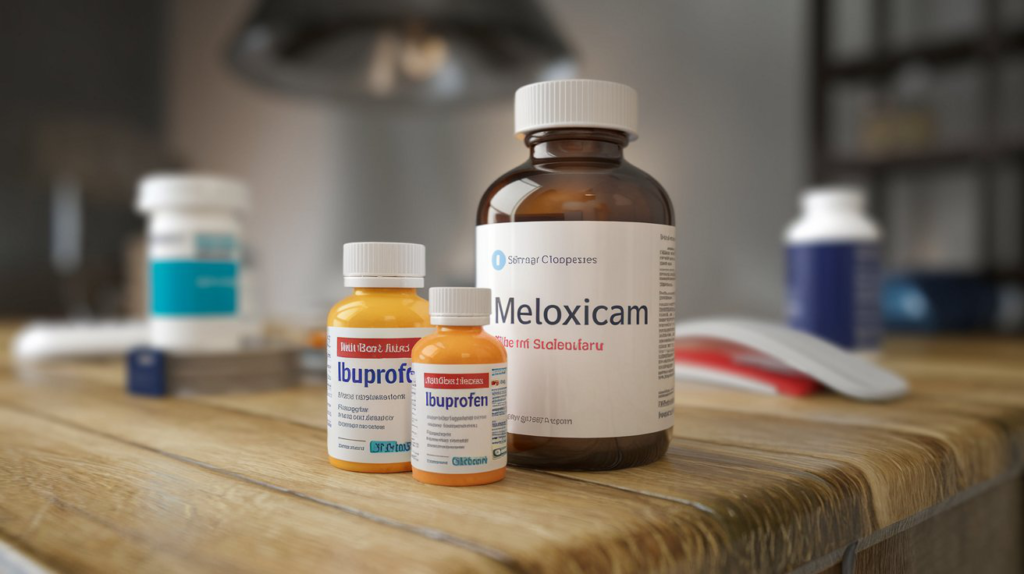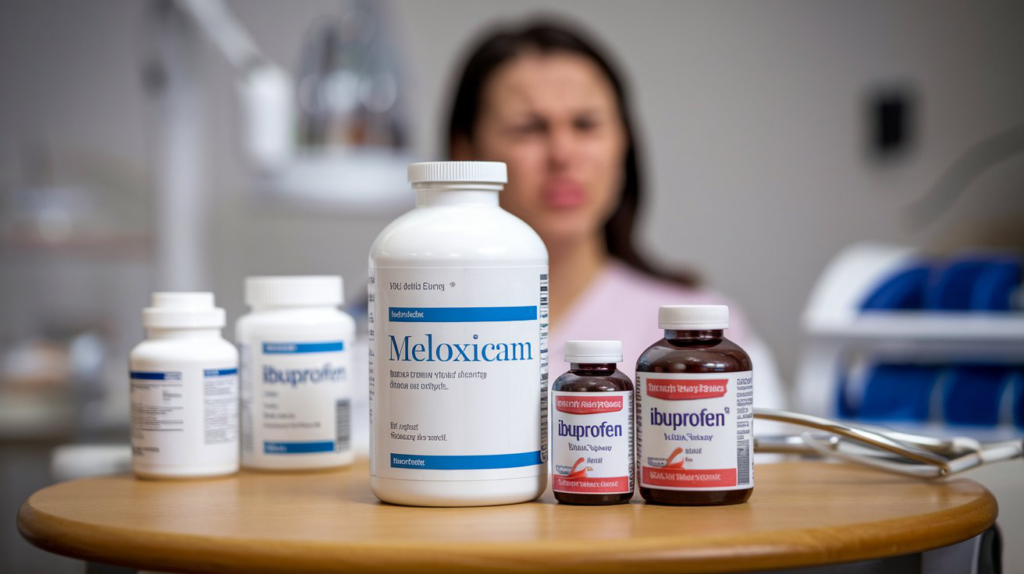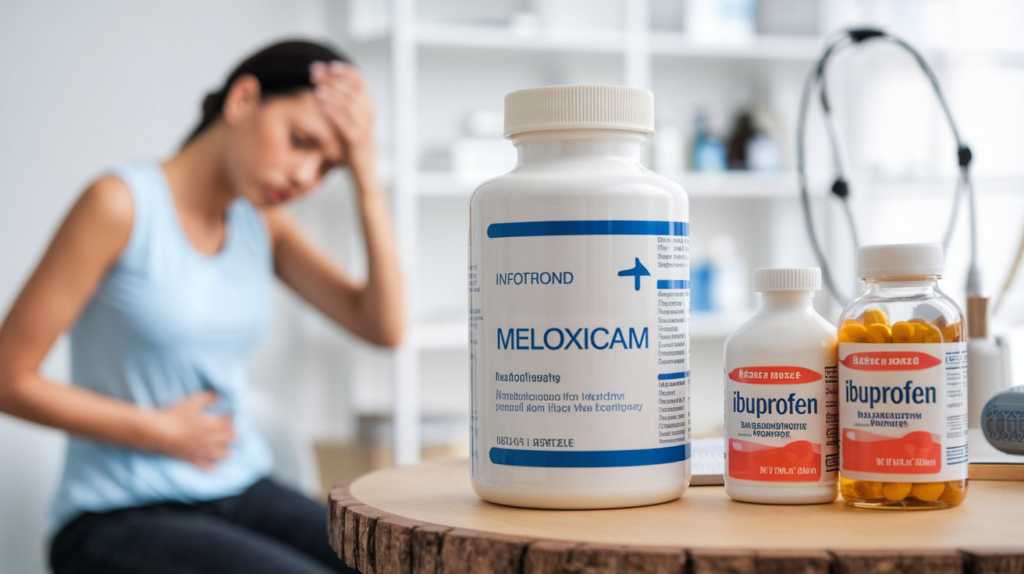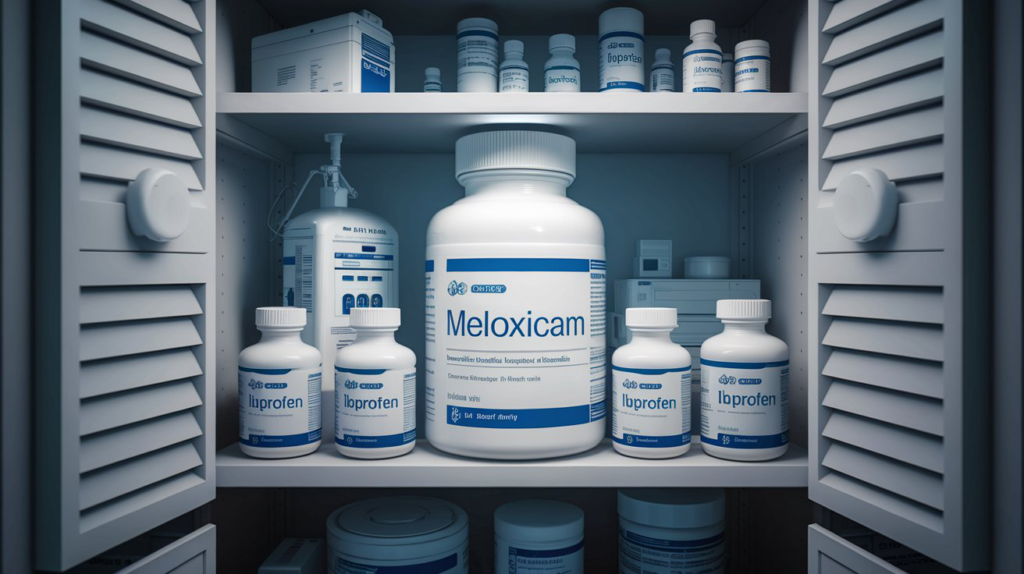Last updated on December 18th, 2024 at 06:17 am
- Key Takeaways
- Understanding Meloxicam and Ibuprofen
- What is Meloxicam?
- What is Ibuprofen?
- How Do They Work?
- Mechanism of Action: How Meloxicam and Ibuprofen Work
- COX Enzymes and Prostaglandin Production
- Selective vs. Non-Selective NSAIDs
- Impact on Pain and Inflammation
- Conditions Treated by Meloxicam and Ibuprofen
- Arthritis Management
- Pain Relief for Other Conditions
- Off-Label Uses
- Dosage and Administration Guidelines
- Standard Dosages
- Frequency of Use
- Special Considerations for Children
- Efficacy: Which is More Effective?
- Clinical Studies and Findings
- Patient Experiences
- Comparative Effectiveness
- Side Effects and Risks
- Common Side Effects
- Serious Adverse Effects
- Long-Term Risks
- Drug Interactions and Contraindications
- Interactions with Other Medications
- Who Should Avoid These NSAIDs?
- Consulting Your Healthcare Provider
- Cost and Insurance Coverage
- Prescription vs. Over-the-Counter Costs
- Cost Comparison Table
- Using Coupons and Discounts
- Warnings and Precautions
- Gastrointestinal Risks
- Cardiovascular Concerns
- Pregnancy and NSAID Use
- Summary Table of Risks
- Conclusion
- Patient Considerations: Choosing Between Meloxicam and Ibuprofen
- Factors to Consider
- When to Consult a Doctor
- Personalizing Pain Management
- Comparing Meloxicam and Ibuprofen for Arthritis Pain
- Effectiveness for Osteoarthritis
- Effectiveness for Rheumatoid Arthritis
- Managing Chronic Pain
- What Are Meloxicam and Ibuprofen?
- How Do They Work?
- Efficacy for Different Types of Pain
- Side Effects and Risk
- Which Is Better for You?
- 1. For Chronic Conditions
- 2. For Acute Pain
- 3. Considering Safety
- Interactions and Considerations
- Meloxicam vs. Ibuprofen: Understanding the Differences, Similarities, and Choosing the Right Option
- What Are Meloxicam and Ibuprofen?
- Side Effects: Understanding the Risk
- Safety Considerations for Long-Term Use
- Choosing the Right Option: Factors to Consider
- Consulting a Healthcare Professional
- Similarities Between Meloxicam and Ibuprofen
- NSAID Class and Mechanism of Action
- Key Differences Between Meloxicam and Ibuprofen
- Duration of Action
- Prescription vs. Over-the-Counter
- Effectiveness and Usage for Joint Pain
- When to Use Meloxicam
- When to Use Ibuprofen
- Side Effects and Safety Concerns
- Risks of Meloxicam
- Risks of Ibuprofen
- Which Is Better for You?
- Consulting a Medical Professional
- Natural Alternatives for Pain Relief
- Frequently Asked Questions
- Which one is stronger, Meloxicam or Ibuprofen?
- Can I take Meloxicam and Ibuprofen together?
- What are the side effects of Meloxicam?
- What are the side effects of Ibuprofen?
- How should I decide between Meloxicam and Ibuprofen?
- Is it better to take Meloxicam or Ibuprofen?
- Why is Meloxicam preferred?
- What is the strongest anti-inflammatory medication?
- Why can’t you drink coffee while taking Meloxicam?
- What is the main side effect of Meloxicam?
- Should I take Meloxicam at night or in the morning?
- What cannot be taken with Meloxicam?
- What is a stronger anti-inflammatory than Ibuprofen?
- Is there a safer alternative to Meloxicam?
- Can you lay down right after taking Meloxicam?
- Will Meloxicam help back pain?
- Does Meloxicam actually reduce inflammation?
- Is Meloxicam a painkiller or muscle relaxer?
- How many mg of Ibuprofen is equal to 15 mg of Meloxicam?
- Is it OK to take 2 Meloxicam 15 mg?
- Is Meloxicam 15 mg very strong?
- Why can’t you drink coffee while taking meloxicam?
- Can I take 800mg ibuprofen with 15 mg meloxicam?
- Should I take meloxicam at night or in the morning?
- What is a good replacement for meloxicam?
- What is a stronger anti-inflammatory than ibuprofen?
- Which is a stronger anti-inflammatory, meloxicam or ibuprofen?
- What is the main side effect of meloxicam?
- Can I take 1000 mg Tylenol with 15 mg meloxicam?
- Will meloxicam help back pain?
- What organ is meloxicam hard on?
- Can I take 800mg ibuprofen with 15 mg meloxicam?
- What is the strongest anti-inflammatory medication?
- Should I take meloxicam at night or in the morning?
- What should not be done while taking meloxicam?
- Does meloxicam help with pain or just inflammation?
- How quickly does meloxicam relieve pain?
- Which is better for inflammation, Tylenol or meloxicam?
- Which is safer, meloxicam or ibuprofen?
- Can you take meloxicam only when needed?
- Can meloxicam cause weight gain?
- Is meloxicam harder on kidneys than ibuprofen?
- Which anti-inflammatory is safest?
- What cannot be taken with meloxicam?
- How long should you take meloxicam for inflammation?
- Does meloxicam give immediate relief?
When it comes to managing pain, meloxicam and ibuprofen are two commonly used medications. Both belong to a class of drugs known as nonsteroidal anti-inflammatory drugs (NSAIDs) and are often prescribed or recommended for similar conditions.
However, there are key differences between them that can influence which one might be better for you. This article explores their similarities and differences, helping you make an informed choice.
Key Takeaways
- Meloxicam is a prescription drug taken once a day, while ibuprofen can be bought over the counter and is taken multiple times a day.
- Meloxicam is generally stronger than ibuprofen and may cause fewer stomach problems, but it requires a prescription.
- Both drugs can interact with other medications, so it’s important to talk to a doctor before using them.
- While effective for pain, both medications can have serious side effects, including heart and stomach issues, especially for those with existing health problems.
- Cost-wise, ibuprofen is usually cheaper and more accessible than meloxicam, which is often covered by insurance.
Understanding Meloxicam and Ibuprofen
What is Meloxicam?
Meloxicam is a type of nonsteroidal anti-inflammatory drug (NSAID) that is often prescribed to help manage pain and inflammation, especially in conditions like arthritis. It is a selective COX-2 inhibitor, which means it targets specific enzymes in the body, leading to fewer gastrointestinal side effects compared to some other NSAIDs. This makes it a popular choice for long-term pain management.


What is Ibuprofen?
Ibuprofen is another NSAID that is widely used for treating mild to moderate pain, fever, and inflammation. It is available over-the-counter under brand names like Advil and Motrin. Unlike meloxicam, ibuprofen is a non-selective NSAID, meaning it affects both COX-1 and COX-2 enzymes. This can lead to more gastrointestinal side effects, especially when taken in higher doses or for extended periods.
How Do They Work?
Both meloxicam and ibuprofen work by blocking the production of prostaglandins, which are chemicals in the body that promote inflammation, pain, and fever. Here’s a quick comparison:
| Feature | Meloxicam | Ibuprofen |
|---|---|---|
| Drug Class | NSAID | NSAID |
| Selectivity | Selective COX-2 inhibitor | Non-selective |
| Common Uses | Arthritis, pain management | Pain relief, fever |
| Dosage Frequency | Once daily | Every 4-6 hours |
Mechanism of Action: How Meloxicam and Ibuprofen Work
COX Enzymes and Prostaglandin Production
Both meloxicam and ibuprofen are nonsteroidal anti-inflammatory drugs (NSAIDs) that help reduce pain and inflammation. They achieve this by blocking cyclooxygenase (COX) enzymes, which are responsible for producing prostaglandins. Prostaglandins are chemicals in the body that promote inflammation and pain. By inhibiting these enzymes, these medications lower the levels of prostaglandins, leading to decreased pain and swelling.
Selective vs. Non-Selective NSAIDs
- Meloxicam is a partially selective NSAID, primarily targeting the COX-2 enzyme. This selectivity can lead to fewer gastrointestinal side effects compared to non-selective NSAIDs.
- Ibuprofen, on the other hand, is a non-selective NSAID, affecting both COX-1 and COX-2 enzymes. This means it can provide broader pain relief but may also increase the risk of stomach issues.
Impact on Pain and Inflammation
The effectiveness of these medications can vary based on the condition being treated. Here’s a quick comparison:
| Medication | COX Selectivity | Common Uses | Dosage Frequency |
|---|---|---|---|
| Meloxicam | COX-2 | Arthritis, chronic pain | Once daily |
| Ibuprofen | COX-1 & COX-2 | Mild to moderate pain, fever | Every 4-6 hours |
Conditions Treated by Meloxicam and Ibuprofen


Arthritis Management
Both meloxicam and ibuprofen are commonly used to treat arthritis, which includes conditions like osteoarthritis and rheumatoid arthritis. Meloxicam is particularly effective for long-term management of these conditions, while ibuprofen is often used for short-term relief.
Pain Relief for Other Conditions
In addition to arthritis, ibuprofen is also used for various types of pain, including:
- Menstrual cramps
- Toothaches
- Muscle aches
- Back pain
Meloxicam is primarily focused on arthritis but can also help with other inflammatory conditions.
Off-Label Uses
Both medications may be prescribed for off-label uses, such as:
- Fever reduction (ibuprofen)
- Pain management in specific conditions (meloxicam)
Here’s a quick comparison of conditions treated by each:
| Condition | Meloxicam | Ibuprofen |
|---|---|---|
| Osteoarthritis | Yes | Yes |
| Rheumatoid arthritis | Yes | Yes |
| Juvenile rheumatoid arthritis | Yes | Yes |
| Dysmenorrhea | Off-label | Yes |
| Mild to moderate pain | Off-label | Yes |
| Fever | Off-label | Yes |
Dosage and Administration Guidelines


Standard Dosages
Meloxicam and ibuprofen have different recommended dosages. For meloxicam, the usual starting dose for adults is 7.5 mg once daily, which can be increased to a maximum of 15 mg per day. In children weighing more than 60 kg, the dose is also 7.5 mg daily. For ibuprofen, the standard over-the-counter dosage is 200 to 400 mg every four to six hours as needed, with a maximum of 1200 mg per day for OTC use. Prescription-strength ibuprofen can go up to 3200 mg per day.
| Medication | Standard Dosage (Adults) | Maximum Daily Dose |
|---|---|---|
| Meloxicam | 7.5 mg once daily | 15 mg |
| Ibuprofen | 200-400 mg every 4-6 hrs | 1200 mg (OTC) |
Frequency of Use
- Meloxicam: Taken once daily, making it convenient for patients.
- Ibuprofen: Can be taken every four to six hours, depending on pain levels.
Special Considerations for Children
- For children under 2 years, the dosage of meloxicam must be determined by a doctor.
- Ibuprofen dosage for children is based on their weight, so it’s important to consult a healthcare provider for the correct amount. Always follow your doctor’s advice when giving medication to children.
Efficacy: Which is More Effective?
Clinical Studies and Findings
Research shows that meloxicam is often considered a stronger medication than ibuprofen. In various studies, meloxicam has been found to provide effective pain relief with fewer gastrointestinal side effects. However, both medications have shown similar effectiveness in managing pain for conditions like arthritis and dental pain.
Patient Experiences
Many patients report that meloxicam works well for chronic pain, especially for arthritis. Some key points from patient feedback include:
- Meloxicam is taken once daily, making it easier to manage.
- Ibuprofen may require multiple doses throughout the day.
- Patients often prefer meloxicam for its longer-lasting effects.
Comparative Effectiveness
A summary of findings from clinical trials comparing meloxicam and ibuprofen is shown below:
| Study Type | Meloxicam Effectiveness | Ibuprofen Effectiveness |
|---|---|---|
| Arthritis Pain | High | Moderate |
| Dental Pain | Similar | Similar |
| Chronic Pain | High | Moderate |
In conclusion, while both medications are effective, meloxicam may offer a stronger option for those needing long-term pain management, especially for arthritis. However, individual responses can vary, so it’s essential to consult with a healthcare provider to determine the best choice for your specific needs.
Side Effects and Risks
Common Side Effects
Both meloxicam and ibuprofen can cause side effects. While many are mild and temporary, some can be serious. Here are some common side effects:
- Abdominal pain
- Nausea or upset stomach
- Dizziness or headaches
Serious Adverse Effects
It’s important to be aware of serious side effects that may require immediate medical attention. These can include:
- Black or bloody stools
- Severe stomach pain or vomiting blood
- Chest pain or rapid heartbeat
Long-Term Risks
Using meloxicam or ibuprofen for a long time can lead to more serious health issues. Some risks include:
- Increased chance of heart attack or stroke, especially in those with existing heart conditions (highlight: heart attack risk)
- Potential for ulcers or bleeding in the stomach (highlight: stomach ulcers)
- Kidney problems, particularly in those with pre-existing conditions
Drug Interactions and Contraindications


Interactions with Other Medications
Taking meloxicam or ibuprofen with certain medications can increase the risk of serious side effects. Always inform your doctor about all medications you are taking. Here are some common interactions:
- Blood Thinners: Medications like warfarin can increase the risk of bleeding.
- Antidepressants: SSRIs and SNRIs may also heighten bleeding risks.
- High Blood Pressure Medications: NSAIDs can reduce the effectiveness of drugs like ACE inhibitors and diuretics.
Who Should Avoid These NSAIDs?
Certain individuals should be cautious or avoid using meloxicam and ibuprofen:
- People with Allergies: If you are allergic to NSAIDs, including aspirin, you should avoid these medications. (See highlight: meloxicam)
- Individuals with Heart Issues: Those with a history of heart disease may face increased risks. (See highlight: myocardial infractions)
- Pregnant Women: Especially after 20 weeks, as it may lead to complications.
Consulting Your Healthcare Provider
Before starting either medication, it’s crucial to consult your healthcare provider, especially if you:
- Have existing health conditions.
- Are taking multiple medications.
- Experience any unusual symptoms after taking these drugs. (See highlight: asthma, headache)


Cost and Insurance Coverage
Prescription vs. Over-the-Counter Costs
When considering the costs of meloxicam and ibuprofen, it’s important to note that:
- Prescription-strength ibuprofen is often covered by insurance plans.
- However, over-the-counter (OTC) ibuprofen is usually not covered.
- Meloxicam, as a generic drug, is typically covered by most insurance plans.
Cost Comparison Table
| Medication | Average Cost (30 Tablets) | Typically Covered by Insurance? | Typical Medicare Copay |
|---|---|---|---|
| Meloxicam (15 mg) | $100 | Yes | $0-$10 |
| Ibuprofen (400 mg) | $30 | Yes (Prescription only) | $0-$22 |
Using Coupons and Discounts
- You can often find coupons for meloxicam that may reduce your overall cash price.
- For ibuprofen, using a SingleCare coupon can lower the cost at participating pharmacies.
- The final price you pay will depend on your insurance coverage, dosage, and pharmacy location.


Warnings and Precautions
Gastrointestinal Risks
Both meloxicam and ibuprofen can lead to serious gastrointestinal issues. NSAIDs like meloxicam may cause ulcers, bleeding, or holes in the stomach or intestine. These problems can develop at any time during treatment. Watch for warning signs such as:
- Severe stomach pain
- Black or tarry stools
- Vomiting blood or material that looks like coffee grounds
Cardiovascular Concerns
Taking NSAIDs can increase blood pressure and the risk of heart problems. People with a history of heart disease should be cautious. High doses of these medications may lead to:
- Heart attacks
- Strokes
- Worsening heart failure
Pregnancy and NSAID Use
NSAIDs should be avoided during pregnancy, especially around 20 weeks or later. Taking these medications during this time may lead to reduced amniotic fluid and other complications. Always consult your healthcare provider before taking any medication during pregnancy.
Summary Table of Risks
| Risk Type | Meloxicam | Ibuprofen |
|---|---|---|
| Gastrointestinal Issues | High | Moderate |
| Cardiovascular Risks | High | Moderate |
| Pregnancy Concerns | Yes | Yes |
Conclusion
Always consult your healthcare provider about the risks associated with meloxicam and ibuprofen. Taking these medications responsibly is crucial for your health.
Patient Considerations: Choosing Between Meloxicam and Ibuprofen
When deciding between meloxicam and ibuprofen, there are several important factors to consider. Your specific health needs and conditions will guide your choice. Here are some key points to think about:
Factors to Consider
- Type of Pain: Meloxicam is often used for chronic pain, especially from arthritis, while ibuprofen is suitable for acute pain like headaches or menstrual cramps.
- Dosage Frequency: Meloxicam is typically taken once daily, making it more convenient for long-term use. In contrast, ibuprofen may need to be taken every 4 to 6 hours.
- Side Effects: Both medications can cause gastrointestinal issues, but meloxicam may have a higher risk of serious side effects, especially for those with existing heart conditions.


When to Consult a Doctor
- If you have a history of heart problems or gastrointestinal issues, it’s crucial to discuss your options with a healthcare provider.
- If you are pregnant or planning to become pregnant, consult your doctor before taking either medication.
- Always seek advice if you are taking other medications to avoid potential interactions.
Personalizing Pain Management
- Consider your lifestyle and how each medication fits into it. For example, if you prefer fewer doses, meloxicam might be better.
- Monitor how your body responds to each medication and report any adverse effects to your healthcare provider.
In summary, choosing between meloxicam and ibuprofen involves understanding your personal health needs and consulting with a healthcare professional to ensure safe and effective pain management.
| Medication | Dosage | Frequency | Common Uses |
|---|---|---|---|
| Meloxicam | 7.5-15 mg | Once daily | Arthritis |
| Ibuprofen | 200-400 mg | Every 4-6 hrs | Pain relief |
Comparing Meloxicam and Ibuprofen for Arthritis Pain


Effectiveness for Osteoarthritis
Both meloxicam and ibuprofen are effective in treating osteoarthritis, a common form of arthritis. Meloxicam is often considered more potent, providing longer-lasting relief with fewer doses. In contrast, ibuprofen typically requires multiple doses throughout the day to manage pain effectively.
Effectiveness for Rheumatoid Arthritis
When it comes to rheumatoid arthritis, both medications can help reduce inflammation and pain. However, meloxicam is often preferred for its once-daily dosing, which can improve patient adherence to treatment. Studies suggest that meloxicam may have fewer gastrointestinal side effects compared to ibuprofen, making it a safer option for long-term use.
Managing Chronic Pain
For chronic pain management, both drugs can be beneficial. Here are some key points to consider:
- Meloxicam is usually prescribed for long-term use and is taken once daily.
- Ibuprofen is available over-the-counter and can be taken as needed, but it may not be suitable for long-term use due to potential side effects.
- Patients should consult their healthcare provider to determine the best option based on their specific condition and medical history.
| Medication | Dosage Frequency | Common Uses | Side Effects |
|---|---|---|---|
| Meloxicam | Once daily | Osteoarthritis, RA | Fewer GI issues |
| Ibuprofen | Every 4-6 hours | Osteoarthritis, RA, pain relief | More GI issues possible |
What Are Meloxicam and Ibuprofen?
Meloxicam is a prescription-only NSAID that provides long-lasting relief for chronic conditions like osteoarthritis and rheumatoid arthritis. Its once-daily dosage makes it convenient for individuals with ongoing inflammation and joint pain. Due to its longer half-life, Meloxicam is typically used for chronic pain management rather than acute pain Learn more here.
Ibuprofen, in contrast, is an over-the-counter NSAID known for treating mild to moderate pain from menstrual cramps, muscle aches, and headaches. It can be taken multiple times per day, offering flexibility but often requiring more frequent doses. Its rapid onset of action makes it ideal for acute pain scenarios Discover more.


How Do They Work?
Both drugs inhibit cyclooxygenase enzymes (COX-1 and COX-2), which are responsible for producing substances that cause inflammation and pain. Meloxicam is slightly more selective for COX-2, which might lead to a lower risk of gastrointestinal side effects compared to non-selective NSAIDs. However, this selectivity is not complete, so stomach upset and gastric bleeding remain possible Find out more.
Ibuprofen’s non-selective inhibition of COX enzymes means it can provide broad relief for a wide range of conditions but comes with a greater likelihood of gastrointestinal issues when used long-term Learn more.
Efficacy for Different Types of Pain
- Meloxicam is often chosen for pain from arthritis due to its sustained anti-inflammatory effect. Clinical studies have demonstrated its effectiveness in managing ankylosing spondylitis and juvenile rheumatoid arthritis Read more.
- Ibuprofen, while less potent in terms of anti-inflammatory effects, provides faster relief, making it ideal for acute pain like dental pain, orthodontic pain, and severe ear pain. Its ability to be used in preoperative administration for minor procedures adds to its versatility Find out more.
Side Effects and Risk
Both Meloxicam and Ibuprofen share similar side effects, such as abdominal pain, nausea, and indigestion. However, their risk profiles differ:
- Meloxicam carries a heightened risk of cardiovascular issues, including myocardial infarction (heart attack) and heart failure, especially in individuals with pre-existing conditions. It is crucial to use the lowest effective dose to mitigate these risks Learn more.
- Ibuprofen has a higher potential for stomach ulcers and gastrointestinal bleeding, particularly with long-term use or high doses. It is often recommended to avoid using Ibuprofen with blood thinners due to increased bleeding risks Find out more.
Which Is Better for You?
1. For Chronic Conditions
- Meloxicam is typically the better choice for managing chronic inflammation and forms of arthritis, such as psoriatic arthritis and idiopathic arthritis, due to its long-acting nature. It is also suitable for individuals who prefer once-daily dosing Read more.
2. For Acute Pain
- Ibuprofen is more effective for acute pain relief, offering rapid onset for conditions like severe pain from injuries, menstrual cramps, and headaches. Its availability as a counter drug makes it a convenient choice for quick relief Learn more.
3. Considering Safety
- Individuals with cardiovascular diseases may need to exercise caution with Meloxicam due to its potential to increase the risk of heart attack. Consulting a healthcare provider before starting Meloxicam is critical for those with a history of high blood pressure or heart disease Find out more.
- Ibuprofen might be safer for short-term use but should be taken with care by those at risk for stomach ulcers and gastric bleeding Discover more.
Interactions and Considerations
When choosing between these medications, it’s essential to understand their potential interactions:
- Meloxicam has fewer drug interactions, making it potentially safer for those on multiple prescription medications Read more.
- Ibuprofen should not be combined with other non-selective NSAIDs like aspirin or naproxen, as this can increase the risk of adverse effects, including kidney damage Learn more.
Meloxicam vs. Ibuprofen: Understanding the Differences, Similarities, and Choosing the Right Option
When managing pain or inflammation, choosing the right medication is essential. Meloxicam and Ibuprofen are common choices in the Nonsteroidal Anti-Inflammatory Drug (NSAID) class. This guide explores their differences, similarities, and which might be better suited for you based on various factors.


What Are Meloxicam and Ibuprofen?
Meloxicam is a prescription NSAID that targets chronic conditions such as rheumatoid arthritis and ankylosing spondylitis. It provides long-term relief by reducing joint pain and inflammation. Because of its extended duration, Meloxicam is generally taken once daily, making it a good choice for chronic pain management Read more.
Ibuprofen, on the other hand, is available over the counter and is used to treat acute pain from conditions like menstrual cramps, muscle aches, and headaches. It can be taken multiple times per day for moderate pain relief Learn more.
- Meloxicam is particularly effective for pain from arthritis and chronic inflammation. It’s often prescribed for conditions like psoriatic arthritis and idiopathic arthritis, where joint inflammation is a key concern. Its once-daily dosage aids in consistent pain relief without frequent dosing Learn more.
- Ibuprofen provides quick relief for acute pain such as dental pain, severe ear pain, and orthodontic pain control. Its over-the-counter availability makes it a versatile choice for everyday pain management Read more.
Side Effects: Understanding the Risk
While both drugs are effective, they carry potential side effects. Meloxicam may cause adverse effects like liver damage and fluid retention. It is also linked to a higher risk of cardiovascular diseases, including Myocardial infarction in individuals with pre-existing conditions Learn more.
Ibuprofen is associated with an increased risk of gastrointestinal bleeding and kidney function issues, especially at higher daily doses. Long-term use of non-selective NSAIDs like Ibuprofen may also elevate the risk of heart attack and heart failure Discover more.
Safety Considerations for Long-Term Use
Meloxicam is generally recommended for chronic conditions due to its long-acting nature. However, individuals at risk for stomach ulcers or cardiovascular events should consult their healthcare provider to determine the safest option. Taking Meloxicam may require regular blood tests to monitor liver toxicity Find out more.
Ibuprofen is suitable for short-term use and may be better for those without a history of stomach pain or heart conditions. If used with blood pressure medication or blood thinners, it is crucial to follow medical advice due to potential drug interactions Learn more.
Choosing the Right Option: Factors to Consider
1. Managing Chronic Conditions
- Meloxicam is often favored for forms of arthritis like rheumatoid arthritis and ankylosing spondylitis due to its long-term effectiveness. It is a viable choice for those who need consistent relief from chronic pain Read more.
2. Immediate Relief for Acute Pain
- Ibuprofen is typically recommended for acute pain relief like severe pain from injuries and menstrual cramps. Its wide range of available forms makes it adaptable for various types of pain Find out more.
3. Minimizing Risk of Adverse Effects
- For those with a history of cardiovascular diseases or chronic inflammation, Meloxicam may present a higher risk of heart-related complications. Consulting a healthcare professional is key to determining the safest medication Learn more.
Consulting a Healthcare Professional
Deciding between Meloxicam and Ibuprofen depends on various factors like medical conditions, body weight, and drug safety. Working closely with a healthcare provider can help tailor the most effective treatment plan, especially when managing autoimmune diseases and inflammatory arthritis Discover more.
For additional resources on managing conditions that involve pain and inflammation, explore how substance-induced psychosis and triggers of psychosis can affect your overall well-being.
For more information on meloxicam with ibuprofen, check out this guide.
Nonsteroidal anti-inflammatory drugs (NSAIDs) like meloxicam and ibuprofen are popular choices for relieving pain and reducing inflammation. If you suffer from joint pain, autoimmune disease, or inflammatory disorders, understanding the differences between these medications can help you choose the right treatment for your condition. This article will explore how these two NSAIDs compare, including their similarities, key differences, effectiveness, and when each might be best for your situation.
Both meloxicam and ibuprofen belong to the NSAID class, which is widely used to treat pain, inflammation, and fever. Meloxicam is often prescribed for long-term management of joint conditions, such as osteoarthritis or rheumatoid arthritis, while ibuprofen is a well-known over-the-counter medication used for temporary relief of pain and inflammation due to various causes like muscle spasms, headaches, and fever.
Meloxicam is considered a long-acting NSAID, meaning that it remains in the body longer, which allows for once-daily dosing. On the other hand, ibuprofen is a short-acting NSAID that typically requires multiple doses throughout the day to maintain its effect.
Similarities Between Meloxicam and Ibuprofen
NSAID Class and Mechanism of Action
Both meloxicam and ibuprofen are non-steroidal anti-inflammatory drugs that work by inhibiting enzymes called COX-1 and COX-2. These enzymes produce prostaglandins, chemicals in the body that contribute to pain, inflammation, and fever. By blocking these enzymes, meloxicam and ibuprofen help reduce the symptoms of arthritis like joint pain and stiffness.
Both drugs are used for treating pain related to inflammatory arthritis, psoriatic arthritis, and osteoarthritis, and can reduce Flu-like symptoms when related to inflammation. While both medications have similar mechanisms of action, the duration and side effects of each differ.
Key Differences Between Meloxicam and Ibuprofen
Duration of Action
One major difference between these two drugs is their half-life—meloxicam has a much longer half-life, which means it only needs to be taken once daily. This makes meloxicam more convenient for people who need continuous pain control. Ibuprofen, on the other hand, is shorter-acting, which often requires taking it multiple times a day for sustained relief.
Prescription vs. Over-the-Counter
Ibuprofen is available over-the-counter, whereas meloxicam is typically a prescription medication. The Food and Drug Administration (FDA) has approved ibuprofen for over-the-counter use, making it accessible for treating minor ailments, while meloxicam requires a healthcare provider’s approval due to its potency and risk of side effects.
Effectiveness and Usage for Joint Pain
When to Use Meloxicam
Meloxicam is often prescribed when long-term management of joint pain or autoimmune disease is necessary. It is particularly effective for managing chronic joint conditions such as rheumatoid arthritis or osteoarthritis due to its extended action. Its effectiveness makes it a popular choice for patients needing consistent, long-lasting relief. However, users should be cautious, as meloxicam carries a higher risk of side effects if used for extended periods, such as gastrointestinal bleeding and cardiovascular events.
For more detailed information, you can check out our comparative analysis of Meloxicam vs. Ibuprofen.
When to Use Ibuprofen
Ibuprofen is highly effective for short-term pain relief and is a good choice for treating acute inflammatory conditions, muscle spasms, or orthodontic pain control. It is often used to treat migraine aura symptoms, ear infection symptoms, and knee osteoarthritis pain. Ibuprofen can also be helpful in reducing fever and addressing mild to moderate post-separator pain after medical or dental procedures.
If you are experiencing pain and need quick relief, ibuprofen’s availability over-the-counter makes it easy to access and use as directed. However, its short duration means it may need to be taken more frequently throughout the day.
Side Effects and Safety Concerns
Risks of Meloxicam
While meloxicam is effective for managing chronic use conditions, it does come with some side effects. The FDA has issued warnings about the potential cardiovascular risks associated with long-term NSAID use, including meloxicam. It can also cause gastrointestinal issues like ulcers and bleeding, especially when used for extended periods without supervision. Monitoring blood levels through blood tests can be essential for anyone taking meloxicam for a prolonged period to ensure drug safety.
Meloxicam is not typically recommended for those with a history of stroke symptoms or other cardiovascular conditions, as the FDA has flagged an increased risk of such adverse effects.
More details on the side effects of meloxicam can be found here.
Risks of Ibuprofen
Ibuprofen also has potential side effects, especially when taken in higher doses or for long periods. The effects of ibuprofen can include gastrointestinal bleeding, kidney issues, and increased blood pressure. It’s important to use ibuprofen for the shortest time possible and at the lowest effective dose to reduce the risk of side effects. Taking ibuprofen without food or in combination with other NSAIDs can also increase the risk of stomach problems.
According to research, people using ibuprofen should be particularly cautious if they have underlying conditions like high blood pressure, kidney disease, or if they drink alcohol frequently [6].
For more on taking ibuprofen safely, visit here.
Which Is Better for You?
Choosing between meloxicam and ibuprofen largely depends on your specific condition, pain level, and how long you need pain relief. If you need a quick-acting medication for acute pain like Minor foot pain, severe ear pain, or orthodontic treatment pain, ibuprofen is likely your best option, as it’s available over-the-counter and works quickly. However, for chronic conditions like psoriatic arthritis or rheumatoid arthritis, meloxicam may provide more consistent relief.
Consulting a Medical Professional
It is essential to consult with a medical professional before starting any new medication, especially if you have preexisting health conditions. A physical exam and medical history will help determine whether meloxicam or ibuprofen is more suitable for you, considering factors like blood levels, underlying autoimmune disorders, and other medications you might be taking.
A healthcare provider can also help you manage dosages of meloxicam or ibuprofen, ensuring you receive the most effective dose with minimal side effects. Taking either medication at the maximum dose or combining it with other counter pain relievers can increase your risk of serious health issues. Always follow a doctor’s recommendation when managing conditions like hip pain, inflammatory disease, or neuropathic pain.
Natural Alternatives for Pain Relief
If you are concerned about the side effects of NSAIDs, consider discussing natural alternatives with your healthcare provider. Options like compresses for ear pain, orthodontic treatment modifications, or even lifestyle changes can help reduce your reliance on medication. Additionally, practicing good joint function habits, staying active, and maintaining a healthy weight can help alleviate symptoms of arthritis.
For more resources on managing pain naturally, you can refer to Cleveland Clinic’s recommendations on NSAIDs and their alternatives.
From Embrace Inner Chaos to your inbox
Transform your Chaos into authentic personal growth – sign up for our free weekly newsletter! Stay informed on the latest research advancements covering:
Narcissistic Personality Disorder (NPD)
Frequently Asked Questions
Which one is stronger, Meloxicam or Ibuprofen?
Meloxicam is generally considered to be stronger than ibuprofen due to its longer duration of action and the fact that it requires only a once-daily dose for effective relief from symptoms like arthritis pain. While both medications are nonsteroidal anti-inflammatory drugs (NSAIDs) used to relieve pain and inflammation, meloxicam is typically used for more chronic, long-term conditions like osteoarthritis and rheumatoid arthritis, whereas ibuprofen is often used for short-term relief of mild to moderate pain (Mayo Clinic).
Can I take Meloxicam and Ibuprofen together?
It is not recommended to take meloxicam and ibuprofen together because both are NSAIDs and taking them concurrently increases the risk of side effects like gastrointestinal bleeding and kidney damage. Instead, it is better to choose one under medical advice to avoid potential health risks (WebMD).
What are the side effects of Meloxicam?
Common side effects of meloxicam include stomach pain, nausea, dizziness, and indigestion. More serious side effects can include gastrointestinal bleeding, high blood pressure, and kidney problems. In rare cases, allergic reactions like skin rashes or anaphylaxis can occur (Mayo Clinic).
What are the side effects of Ibuprofen?
Ibuprofen side effects may include upset stomach, heartburn, headache, and dizziness. More serious effects can include gastrointestinal ulcers, kidney problems, and an increased risk of heart attack or stroke, especially with long-term use or in higher doses (WebMD).
How should I decide between Meloxicam and Ibuprofen?
The decision between meloxicam and ibuprofen depends on the nature and duration of your pain. Meloxicam is often chosen for chronic, arthritis-related pain due to its once-daily dosing and longer-lasting effects, whereas ibuprofen is more suitable for short-term, acute pain management. Consulting a healthcare provider is essential for the best choice based on your health history (Mayo Clinic).
Is it better to take Meloxicam or Ibuprofen?
Meloxicam is generally better for managing chronic arthritis-related pain because it provides sustained relief over a longer period. On the other hand, ibuprofen is better suited for short-term pain, such as headache or muscle strain. The choice should depend on the type of pain and medical recommendations (WebMD).
Why is Meloxicam preferred?
Meloxicam is often preferred for chronic conditions because it provides longer-lasting relief with once-daily dosing, making it more convenient for long-term management of conditions like osteoarthritis and rheumatoid arthritis. Its formulation aims to reduce the incidence of gastrointestinal side effects compared to some other NSAIDs (Mayo Clinic).
What is the strongest anti-inflammatory medication?
The strongest anti-inflammatory medication varies by individual needs. Generally, prescription NSAIDs like meloxicam or celecoxib are considered stronger than over-the-counter options like ibuprofen or naproxen. In severe cases, corticosteroids are used for their potent anti-inflammatory effects (WebMD).
Why can’t you drink coffee while taking Meloxicam?
Caffeine can increase the risk of stomach irritation and gastrointestinal issues when taken with NSAIDs like meloxicam. Both substances can increase stomach acid, which may lead to ulcers or stomach discomfort if taken together frequently (Mayo Clinic).
What is the main side effect of Meloxicam?
The main side effect of meloxicam is gastrointestinal irritation, which can range from mild stomach discomfort to more severe conditions like ulcers or bleeding. It can also lead to increased blood pressure and potential kidney issues with prolonged use (Mayo Clinic).
Should I take Meloxicam at night or in the morning?
Meloxicam is typically taken once daily, either in the morning or night, based on your personal routine and any potential side effects like drowsiness or stomach upset. It’s advisable to take it with food to reduce stomach irritation (WebMD).
What cannot be taken with Meloxicam?
Meloxicam should not be taken with other NSAIDs, blood thinners like warfarin, or certain blood pressure medications (ACE inhibitors). These combinations can increase the risk of serious side effects such as bleeding or kidney problems (Mayo Clinic).
What is a stronger anti-inflammatory than Ibuprofen?
Meloxicam and celecoxib are considered stronger anti-inflammatory medications compared to ibuprofen due to their potency and longer duration of action. These are typically used for more chronic pain conditions (WebMD).
Is there a safer alternative to Meloxicam?
Acetaminophen (Tylenol) can be a safer alternative for pain relief, especially for those who cannot tolerate NSAIDs due to gastrointestinal issues. However, it lacks the anti-inflammatory properties of meloxicam and should be used under medical advice (Mayo Clinic).
Can you lay down right after taking Meloxicam?
It is advisable to avoid lying down immediately after taking meloxicam to reduce the risk of gastrointestinal discomfort or acid reflux. Staying upright for at least 30 minutes helps in preventing any irritation to the esophagus (WebMD).
Will Meloxicam help back pain?
Meloxicam can be effective for reducing inflammation and pain in conditions such as back pain, especially if inflammation is involved. However, it is most commonly used for chronic conditions like arthritis (Mayo Clinic).
Does Meloxicam actually reduce inflammation?
Yes, meloxicam reduces inflammation as it is an NSAID designed to inhibit the enzymes responsible for inflammation, helping in conditions like osteoarthritis and rheumatoid arthritis (WebMD).
Is Meloxicam a painkiller or muscle relaxer?
Meloxicam is a nonsteroidal anti-inflammatory drug (NSAID), not a muscle relaxer. It primarily works by reducing inflammation and alleviating pain associated with conditions like arthritis (Mayo Clinic).
How many mg of Ibuprofen is equal to 15 mg of Meloxicam?
The equivalency between ibuprofen and meloxicam can vary, but generally, 15 mg of meloxicam is roughly equivalent in anti-inflammatory effect to higher doses of ibuprofen (approximately 800 mg taken multiple times daily). Always consult with a healthcare provider for accurate dosing (WebMD).
Is it OK to take 2 Meloxicam 15 mg?
No, taking two 15 mg doses of meloxicam is not recommended as it can significantly increase the risk of severe side effects like gastrointestinal bleeding and kidney issues. Always follow the prescribed dose (Mayo Clinic).
Is Meloxicam 15 mg very strong?
Meloxicam 15 mg is considered a strong NSAID dose, especially for managing chronic arthritis-related pain. It is often prescribed for patients who require more sustained relief compared to over-the-counter NSAIDs (WebMD).
Why can’t you drink coffee while taking meloxicam?
Meloxicam can cause gastrointestinal irritation, and combining it with caffeine (which is also a gastric irritant) may increase the risk of stomach problems such as ulcers or bleeding. Caffeine can further worsen these side effects by affecting the enzymes that break down meloxicam in your body, potentially leading to dangerous drug levels or diminished effectiveness. It is advised to avoid caffeine while taking meloxicam to minimize these risks Mayo Clinic.
Can I take 800mg ibuprofen with 15 mg meloxicam?
It is not recommended to take ibuprofen and meloxicam together, as both are nonsteroidal anti-inflammatory drugs (NSAIDs) that can significantly increase the risk of stomach ulcers, bleeding, and kidney damage. Always consult with your healthcare provider before combining NSAIDs to avoid adverse interactions Mayo Clinic.
Should I take meloxicam at night or in the morning?
There is no strict rule about taking meloxicam in the morning or at night. It is important to take it at the same time each day for consistency. Depending on how you respond to the medication, taking it in the morning may help manage daytime symptoms, whereas at night it could help if you have nighttime pain WebMD.
What is a good replacement for meloxicam?
Other NSAIDs, such as celecoxib or naproxen, are often considered alternatives to meloxicam, depending on individual medical needs and tolerances. Acetaminophen is also an option for those needing a pain reliever without the anti-inflammatory properties. It’s crucial to consult with your doctor to find the best replacement based on your medical history Mayo Clinic.
What is a stronger anti-inflammatory than ibuprofen?
Meloxicam is generally considered stronger than ibuprofen, as it is often prescribed for long-term management of inflammatory conditions like osteoarthritis or rheumatoid arthritis. It has a longer half-life, meaning it can be taken less frequently compared to ibuprofen, which needs more frequent dosing to achieve the same effect WebMD.
Which is a stronger anti-inflammatory, meloxicam or ibuprofen?
Meloxicam is typically stronger than ibuprofen due to its longer duration of action and its ability to target inflammation more effectively over time. Meloxicam is a prescription NSAID, whereas ibuprofen is available over the counter and is often used for milder cases of inflammation Mayo Clinic.
What is the main side effect of meloxicam?
The main side effect of meloxicam is gastrointestinal discomfort, which can include stomach pain, heartburn, nausea, and an increased risk of ulcers or bleeding. Long-term use also carries risks of cardiovascular issues and kidney impairment Mayo Clinic.
Can I take 1000 mg Tylenol with 15 mg meloxicam?
It is generally safe to take acetaminophen (Tylenol) with meloxicam, as they work in different ways and do not belong to the same drug class. However, you should always consult with your healthcare provider before combining medications to avoid any potential side effects or interactions WebMD.
Will meloxicam help back pain?
Meloxicam can help with back pain that is related to inflammation, such as in cases of arthritis or injury. However, it may not be effective for all types of back pain, especially if the pain is not inflammation-related Mayo Clinic.
What organ is meloxicam hard on?
Meloxicam can be hard on the kidneys and stomach. Long-term use increases the risk of kidney damage and gastrointestinal issues like ulcers or bleeding, especially in people with existing health concerns Mayo Clinic.
Can I take 800mg ibuprofen with 15 mg meloxicam?
It is generally not recommended to take ibuprofen with meloxicam because both are NSAIDs and can significantly increase the risk of serious side effects like stomach ulcers, gastrointestinal bleeding, and kidney damage. Combining these two medications amplifies their impact on the gastrointestinal system, which can be very harmful. Always consult your healthcare provider before combining any NSAIDs to ensure safety Mayo Clinic.
What is the strongest anti-inflammatory medication?
Corticosteroids, such as prednisone, are among the strongest anti-inflammatory medications. They are more potent than typical NSAIDs like ibuprofen or meloxicam and are used to treat severe inflammation caused by conditions like rheumatoid arthritis or severe allergies. However, they come with significant side effects, especially when used long-term, including immune suppression, osteoporosis, and increased risk of infections Mayo Clinic.
Should I take meloxicam at night or in the morning?
Meloxicam can be taken either in the morning or at night, but the key is to take it at the same time every day for consistent results. Depending on the nature of your symptoms—whether they are more bothersome during the day or night—you might adjust your dosing time accordingly. Consult your healthcare provider for personalized recommendations based on your specific situation Mayo Clinic.
What should not be done while taking meloxicam?
While taking meloxicam, avoid consuming alcohol and caffeine as they increase the risk of gastrointestinal bleeding and irritation. Additionally, do not combine meloxicam with other NSAIDs (such as ibuprofen or aspirin) as this could elevate the risk of severe side effects like stomach ulcers and kidney damage. Always discuss potential medication and food interactions with your healthcare provider Mayo Clinic.
Does meloxicam help with pain or just inflammation?
Meloxicam works to reduce both pain and inflammation, making it effective for conditions like arthritis. It does not provide immediate pain relief but rather helps to reduce inflammation over time, which in turn decreases pain. It is particularly useful for managing chronic inflammatory conditions Mayo Clinic.
How quickly does meloxicam relieve pain?
Meloxicam may take several hours to start providing pain relief, with its maximum effects often being noticed after a few days of consistent use. It is not intended for immediate pain relief, but rather for reducing inflammation and pain over the longer term Mayo Clinic.
Which is better for inflammation, Tylenol or meloxicam?
Meloxicam is generally better for reducing inflammation compared to acetaminophen (Tylenol), as Tylenol is primarily a pain reliever without significant anti-inflammatory properties. If inflammation is a key concern, meloxicam is more suitable; however, acetaminophen is often preferred for those who cannot tolerate NSAIDs due to its lower risk of gastrointestinal issues Mayo Clinic.
Which is safer, meloxicam or ibuprofen?
Meloxicam may be considered safer than ibuprofen for long-term use in some individuals due to its more targeted action and longer half-life, allowing for once-daily dosing. However, both medications carry risks, particularly for gastrointestinal and cardiovascular side effects, and should be used under medical supervision. Consult your doctor to determine which is safer for your particular needs Mayo Clinic.
Can you take meloxicam only when needed?
Meloxicam is usually prescribed to be taken daily, as it works best when taken consistently to manage chronic conditions like arthritis. It is not recommended to take meloxicam on an “as-needed” basis, as its full anti-inflammatory effects depend on steady levels in the body over time Mayo Clinic.
Can meloxicam cause weight gain?
Yes, meloxicam may cause weight gain as a side effect, often related to fluid retention or swelling. If you notice significant weight gain, it’s important to inform your healthcare provider as this could indicate other underlying issues such as kidney problems Mayo Clinic.
Is meloxicam harder on kidneys than ibuprofen?
Both meloxicam and ibuprofen can be hard on the kidneys, especially when used in high doses or over a long period. The risk may be slightly lower with meloxicam due to its longer duration of action, allowing for less frequent dosing. However, any NSAID can impair kidney function, particularly in individuals with pre-existing kidney issues Mayo Clinic.
Which anti-inflammatory is safest?
Acetaminophen is generally considered one of the safest options for pain relief if inflammation is not a primary concern, as it lacks the gastrointestinal and cardiovascular risks associated with NSAIDs. Among NSAIDs, COX-2 inhibitors like celecoxib may be somewhat safer for gastrointestinal health compared to traditional NSAIDs, but they still pose risks, particularly for cardiovascular health Mayo Clinic.
What cannot be taken with meloxicam?
Meloxicam should not be taken with other NSAIDs like aspirin or ibuprofen, as combining these medications increases the risk of severe side effects such as gastrointestinal bleeding and kidney damage. Additionally, certain blood thinners and corticosteroids may interact negatively with meloxicam. Always consult with your healthcare provider before combining meloxicam with other medications Mayo Clinic.
How long should you take meloxicam for inflammation?
Meloxicam is often prescribed for chronic inflammatory conditions and can be taken for extended periods under medical supervision. The duration of treatment will depend on your specific condition and how well you tolerate the medication. Regular follow-up with your healthcare provider is essential to monitor for any potential side effects Mayo Clinic.
Does meloxicam give immediate relief?
Meloxicam does not provide immediate pain relief; it may take several hours to start working and a few days to achieve its full effect. It is designed for long-term inflammation management rather than quick pain relief Mayo Clinic.




